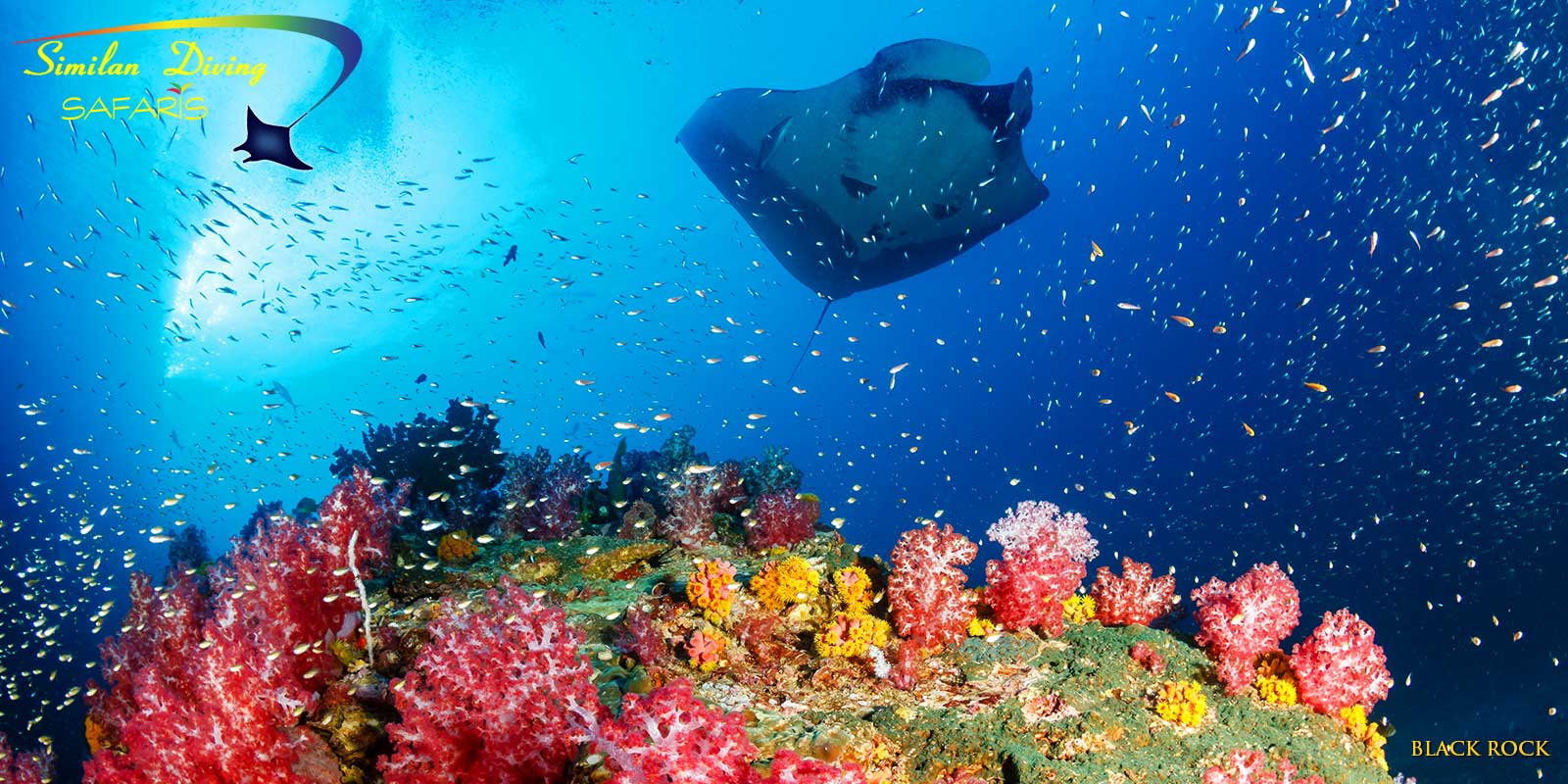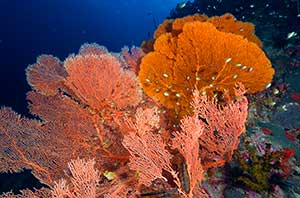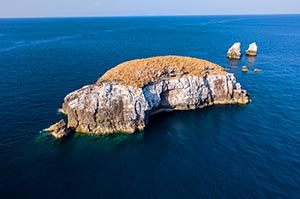Dive Sites
The sheer number of islands gives us the chance to make discovery dives on sites never dived before. Our aim is to show you the very best diving the Mergui Archipelago has to offer.
Here are some of the dive sites that we will visit on our Myanmar liveaboard.
Myanmar information
Fan Forest Pinnacle
*Difficulty Level: Medium
Fan Forest is located exactly five nautical miles north of Western Rocky and away from all other islands. It’s best dived on a rising tide.
The pinnacle rises from 60+ meters up to five meters below the surface. The dive requires a live entry where the captain will position you over the dive site and when you jump in, you swim down to the pinnacle, then stop and check the current.
It’s best to swim into the current and over the side of the dive site then swim around and end the dive down current. The boat will pick you up on the surface away from the pinnacle. A surface marker buoy is essential here.
Underwater you find a huge rock shaped like a pyramid. Part of the rock drops straight down to depth while other areas step down in stages with sand banks forming steps at 15, 30 and 45 meters. In the sand we look for leopard sharks and rays and on the walls we find large gorgonian fans bathed by plankton-rich water.
Don’t try to swim around the whole site in one dive. It’s possible but a lot of work. There is little need to see the whole thing as every bit of it is covered with marine life. One highlight here is watching mating cuttlefish.
Western Rocky
*Difficulty Level: Medium
Crayfish Cave and Eagle’s Nest are the two dive main sites at Western Rocky. Crayfish Cave is located on the main rocky islet and features a cave and an arch starting in 22 meters of water, then sloping up as you enter the cave. Usually there is a friendly school of stripped snapper hovering around with lots of colorful seafans. The arch itself is big and dramatic, a great backdrop for photos. The tunnel exits out the other side so it’s a complete swim-through of the rock. It’s an easy cavern but better dived with a light as it’s pitch black for the first few meters.
Inside the cavern you’ll find colorful sponges lining the ceiling and sides and a gravel bottom which keeps the visibility good. Sweeper fish and lobsters or crayfish occupy the cavern. You may spend 10 or more minutes inside the island, there is a lot to see top to bottom. It’s safe as the entrance and exits are easy to see, light or no light. It requires no special training.
As you exit the tunnel you have a choice to turn left or right. If the current is mild you may swim over to Eagles Nest but usually it’s better to dive the sites separately. The wall is covered with crinoids, sponges, soft corals and hard corals. Fish life is excellent and plentiful.
Eagles Nest is one of the very best dives in the archipelago as you never know what you’re going to see here. If you are lucky enough to see large pelagics during your cruise, Eagles Nest and Black Rock are the two places you will see them. Whale sharks and shovelnose rays visit the area as well as barracuda, schools of jack fish, snappers, and fusiliers. The dive site pumps with action. Deeper at Eagles Nest is one of the best fields of colorful sea fans you’ll find in the Andaman Sea. And moving up to the shallow waters you’ll find frogfish, ghost pipefish and harlequin shrimp living in the crevices and and sponge-covered overhangs. It’s a perfect dive as you are entertained at every depth.
Burma Banks
*Difficulty Level: Advanced
Far offshore of the Mergui Archipelago lie a series of submerged mountaintops that are collectively known as the Burma Banks, a name given to the area by dive shop owners back in the late 1980s. You won't see this name on any chart. Surrounded by open sea in all directions, these remote, widely separated reefs were first dived in the early 1990s. Prior to this time, these seamounts were known to exist, yet nautical charts did not accurately represent their positions. After an extensive series of exploratory trips by several Phuket-based liveaboards equipped with the then new GPS devices, a total of five sandy banks were eventually located, four of which were dived regularly: Roe Bank, Rainbow Reef, Big Bank and Silvertip Bank. We dived this area before we had permission to visit the Mergui Archipelago proper as these banks are located in international waters. Permission to dive Mergui Archipelago itself didn’t come until 1997.
The majority of dive-able areas at the banks are fairly flat, broad plateaus, typically about one kilometer in diameter. The shallowest depths are 21 to 24 meters, making for short bottom times but Nitrox gives us longer dives. Silvertip Bank is usually the last stop as much of the reef reaches within 15 meters of the surface. Unfortunately there are no walls here, only slightly sloping sand banks. At Silvertip, however, there are two good sloping drop-offs, one on each side of the bank, with good coral growth in shallow water. If currents are just right you may start deeper and swim shallow. The water surrounding all the banks is quite deep, averaging 250-300 meters.
Marine life at the banks is healthy and abundant in most areas, although the diversity of species does not compare with the inshore areas. Most have a high percentage of live coral, but there are also areas of dead coral and rubble, probably caused by southwest storms or crown of thorns. Even these areas have interesting features, however, as there are many huge, ancient coral bommies scattered across the reef top, some of which have formed bizarre and intriguing shapes. Hard corals are the norm unlike our dives in the archipelago. Most other types of marine invertebrates are found here as well, although the banks will probably never be known as a great place for critters. Reef fish include many varieties found in other regions, although fewer species are represented. Because of their proximity to deep water, the banks are an excellent place to see open-water predators like rainbow runners, bonito, and husky dogtooth tuna.
In spite of the features mentioned above, the main reason most people went to the Burma Banks was to see sharks. Altogether, at least nine species have been seen here, including rare encounters with tigers and scalloped hammerheads. Unfortunately, shark fishing in the early 2000s got most of the silvertips and nurse sharks which were very common at one time. As of this writing in 2018, reports are good regarding new sightings of juvenile sharks. If this trend continues, the Burma Banks may come back to their former diving glory.
Diving at the Banks is nearly always exciting and rewarding, but it is not for everyone. This is real open-ocean diving–no sheltered anchorages or islands to hide behind, just open sea in all directions making supervision a priority for safe diver picks ups, especially as the weather can change for the worse during the dive. Although surface conditions may be glassy calm, it can also be very rough, especially when choppy seas are caused by wind opposing current. Most sites are quite deep, and strong, changeable currents are very common. Not all boats dive the banks, though the area is becoming more attractive again lately mostly due to the curiosity of new operators.
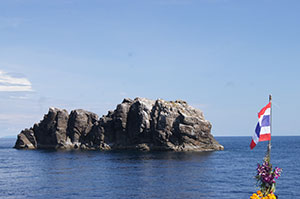
Black Rock
*Difficulty Level: Easy
This large barren rock lying in the middle of nowhere in the central archipelago is considered to be the highlight of any trip and generally the furthest north most boats visit. The surrounding water is deeper than in the rest of the archipelago, attracting pelagic fish. Black Rock is famous as a cleaning station for oceanic manta rays.
The mantas come through to be cleaned by cleaner fish, hang around the rock for a day or two and then move along to parts unknown (though some are being tagged and tracked now.) They come within a few centimeters of divers and interact with us. The rock also attracts schooling fish, including several species of jacks and fusiliers while dense schools of glassfish hover over the coral heads.
Game fish circle the rock. The soft and hard corals are healthy and vibrant, and the visibility is normally excellent. Reef life is typical of the Andaman Sea, lionfish, scorpionfish, anemones and anemonefish, octopus, cuttlefish, stonefish, moray eels–all are very common on this rock and in the rest of the archipelago. Among other moray species seen regularly are jeweled, zebra, fimbriated and white-eyed, the latter two of which are sometimes seen snuggling together in the same crevice.
Boats usually spend a full day here or longer as there are no other dive sites close by. Conditions change with the tides so each dive is unique. When the dive site is happening, it’s really happening and is one of the best dives anywhere.
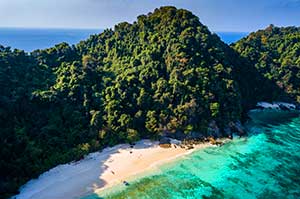
Candy Canyon and Rainbow Rock
*Difficulty Level: Medium
Candy Canyon and Rainbow Rock are the 2 main dive sites in the central area of the archipelago. These are considered inshore dive sites and the water is full of plankton and algae making for a very healthy marine environment.Although visibility is not as good here as in other places, it’s worth spending a day or two exploring, especially if you enjoy seeing critters and macro.
This is the critter and soft coral capital of the Mergui Archipelago.
All the dive sites here are bathed with currents which are often very strong (depending on tidal flow.) The soft limestone rocks are littered with canyons, caverns and pinnacles which make for lots of hiding places for marine life. The soft corals really shine here and show especially vibrant oranges, yellows, pinks and purples. Candy Canyon and Rainbow Rock are named because of this rainbow of color.
There are quite a few dive sites in this area. Over the years some have gotten better and some have declined so it’s always an exploratory journey during the days we are here. If currents are very strong, we’ll dive in areas where we can drift. If currents are mild we can jump on dive sites which have swim-throughs and interesting underwater topography.
Nudibranch geeks go nuts in this area especially if they venture out into the sandy areas surrounding the reefs. It seems we always see something new here. Invertebrates are well represented with shellfish, feather stars, hermit crabs, tube anemones, burrowing sea cucumbers, sea stars, and dozens of types of shrimp and crab.
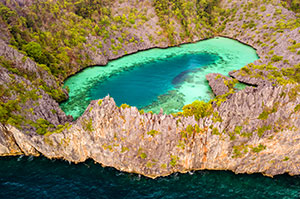
Shark Lagoon
*Difficulty Level: Easy
Often the first or the last dive of a trip, Shark Lagoon is located near the Thai border and is the closest good dive site to Kawthaung, our port of entry and exit.
This island as seen from the air is more lagoon than island with one large shallow area which is connected by a short overhang to the open ocean.
At high tide, you have to enter by ducking down, holding your breath or using your regulator. At low tide you may just swim inside.
Inside the lagoon you may remove your BCD and weight belt and swim around. It’s quite large and to swim from end to end would take most people 30 minutes or more.
There is a sandy bottom with sparse coral growth and the view up to the jungle covered cliffs is spectacular. It would be a good bird watching area if one had the time to spend a few hours in the lagoon with a kayak.
